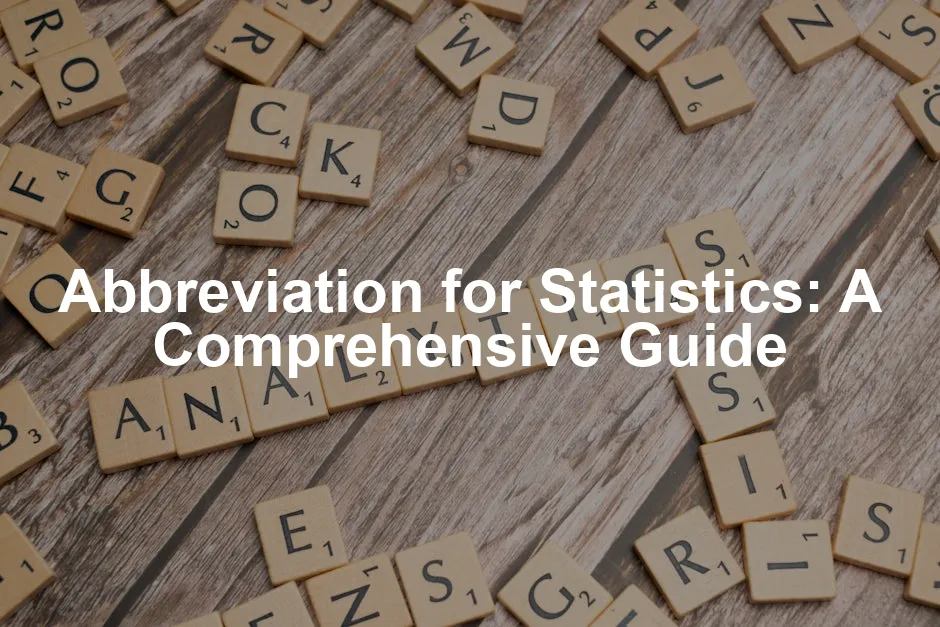Introduction
In the realm of statistics, abbreviations play a crucial role. They serve as shorthand that simplifies communication and enhances understanding. Whether you’re knee-deep in academic research or strategizing in business, knowing these abbreviations helps you navigate the statistical landscape with ease.
Statistics is steadily gaining importance across various fields. In business, data-driven decisions rely heavily on statistical analysis. Healthcare professionals use statistics to evaluate treatments and predict patient outcomes. Social scientists employ statistical methods to analyze trends and behaviors. With statistics at the forefront of these disciplines, understanding its abbreviations becomes indispensable.
What can you expect from this article? We’ll start by outlining key terms and concepts in statistics. Then, we’ll dive into an extensive list of common abbreviations, along with their meanings and real-world applications. By the end, you’ll be well-equipped to decode the language of statistics and apply it effectively in your work or studies.
Statistics isn’t merely a collection of numbers; it’s a powerful tool that provides insights and drives decisions. So, let’s gear up and get ready to unpack the fascinating world of statistical abbreviations!

Understanding Statistics
What is Statistics?
Statistics is a branch of mathematics focused on collecting, analyzing, interpreting, and presenting data. It provides a framework for making sense of numerical information. Through statistical techniques, we can transform raw data into meaningful insights.
Statistics can be categorized into two main types: descriptive and inferential. Descriptive statistics summarize data from a sample. They offer a glimpse into the data’s overall trends and patterns without making conclusions beyond the immediate data. Think averages, medians, and modes—all tools that help portray data succinctly. For a deeper look at descriptive statistics, check out descriptive statistics in manufacturing plant.
A comprehensive understanding of descriptive statistics is crucial for effective data analysis. Learn more about descriptive statistics in manufacturing plant.
Inferential statistics, on the other hand, take a step further. They allow us to make predictions or generalizations about a larger population based on a sample. It’s like taking a bite of a delicious cake and guessing the recipe. Inferential statistics use probability theory to estimate population parameters, giving us confidence in our predictions.
The significance of statistics spans various fields. In healthcare, it aids in clinical trials, helping professionals assess the effectiveness of new treatments. Economists use statistics to analyze market trends, informing policy decisions. Social scientists rely on statistical methods to understand human behavior and societal patterns. As you can see, statistics is not just a dry subject; it’s a vibrant field that fuels innovation and understanding in countless areas.
So, whether you’re crunching numbers in a boardroom or evaluating survey results in a research paper, statistics is your ally. Understanding its principles and jargon, including the essential abbreviations, is crucial for effective communication and informed decision-making. Let’s dive deeper into the role of abbreviations in this fascinating field!

The Role of Abbreviations in Statistics
Why Use Abbreviations?
Using abbreviations in statistics is like having a Swiss Army knife in your pocket—it’s all about efficiency! These handy shortcuts save time and space, making communication clearer. Imagine writing “standard deviation” every time. That’s a mouthful! Instead, just whip out “SD,” and you’re good to go.
Abbreviations streamline conversations. In the fast-paced world of academia or business, who has time to say “statistical analysis” when “stats” will do? They also enhance readability. Readers can quickly grasp complex concepts without getting bogged down by lengthy terms. Think of it as a VIP pass to understanding statistical lingo!
If you want to master the statistical world, consider reading Statistics for Dummies. This gem breaks down complex concepts into bite-sized pieces, making it perfect for beginners or anyone looking to brush up on their stats skills!
Common Contexts for Abbreviations
Where do these beloved abbreviations thrive? They’re practically everywhere! Academic papers are a primary playground for statistical abbreviations. Researchers use them to maintain clarity and brevity in their work. No one wants to wade through pages of jargon, right?
Reports and presentations are another arena where abbreviations shine. They help convey crucial information quickly. Imagine presenting data to a room full of stakeholders. Using “ANOVA” instead of “analysis of variance” keeps the audience engaged and informed.
In classrooms, students often refer to their statistics courses informally as “Stats.” This casual usage fosters a friendly, approachable atmosphere. It’s much easier to say you’re taking “Stat 101” than to spell out “Introduction to Statistics.”
Speaking of friendly and approachable, if you’re looking for a more engaging read, grab a copy of Naked Statistics: Stripping the Dread from the Data. This book hilariously demystifies statistics, making it a must-read for anyone who’s ever felt intimidated by numbers.
In summary, abbreviations in statistics improve communication efficiency, enhance clarity, and are widely used in academic settings, reports, and casual conversations. They’re not just shortcuts; they’re essential tools for anyone navigating the statistical landscape.

Abbreviation Systems
ISO Standards
When it comes to academic publishing, the ISO 4 abbreviation system is the gold standard. This system, established by the International Organization for Standardization, provides a uniform method for abbreviating the titles of scientific journals. Want to reference the “Statistics Education Research Journal“? Just use “Stat. Educ. Res. J.” It’s short, sweet, and universally accepted. This makes citation processes smoother and helps readers quickly identify journals without getting lost in lengthy titles.
The relevance of ISO 4 cannot be overstated. It’s like the universal remote of academic publishing—one format fits all! Adhering to this standard not only promotes clarity but also enhances the credibility of your work. Imagine submitting a paper with correct abbreviations; that’s a step towards academic respectability!
NLM and CASSI Systems
Now, let’s sprinkle in some spice with the NLM and CASSI systems! The National Library of Medicine (NLM) abbreviation system is a go-to for biomedical sciences. It simplifies journal titles in this specific field. If you’re diving into medical research, you’ll need to familiarize yourself with this system.
On the other hand, CASSI (CAS Source Index) caters to the chemistry crowd. Need to reference a chemistry journal? CASSI has you covered! These systems are tailored to their respective fields, ensuring that abbreviations are not only concise but also contextually relevant.

Contextual Usage of Abbreviations
Academic Papers
Using abbreviations in academic papers can feel like walking a tightrope. Best practices suggest defining your abbreviations the first time they appear. For example, if you plan to use “ANOVA” later on, spell it out as “analysis of variance (ANOVA)” initially. This way, the reader knows exactly what you’re talking about. And remember, consistency is key! Stick to your abbreviations throughout the paper to avoid any confusion.
Presentations
In the world of presentations, abbreviations can be your best friend! They allow you to convey complex information quickly. When crafting slides, use abbreviations like “SD” for standard deviation and “CI” for confidence interval. Just keep it simple; don’t throw in too many abbreviations at once. Your audience will appreciate clarity over chaos.
Think of it as inviting guests to a dinner party. You want to make it easy for them to understand the menu without feeling overwhelmed.
Informal vs. Formal Usage
Now, when should you use abbreviations casually, and when should you go formal? Well, it’s all about context! In informal settings, like chatting with friends or writing notes, “stats” is perfectly acceptable. But when it comes to formal writing—like research papers or presentations—stick to the full term “statistics.”
This distinction is crucial. Using “stats” in a formal setting could make you seem less professional. So, know your audience and adjust accordingly. If you’re unsure, err on the side of caution and spell it out!

Case Studies and Examples
Statistics Education Research Journal: The abbreviation for this journal is “Stat. Educ. Res. J.” Proper formatting of abbreviations is crucial in academic writing. It helps maintain clarity and professionalism. Using standardized abbreviations, like this one, ensures that readers can easily recognize and locate the journal in citations. This practice not only streamlines communication but also adheres to ISO standards, enhancing the credibility of academic work.
Statistics Surveys: Similarly, “Statistics Surveys” is abbreviated as “Stat. Surv.” This abbreviation is widely accepted in academic circles, particularly in research and data analysis. It serves to simplify references while maintaining the integrity of the source material. Understanding these abbreviations helps researchers and students alike communicate effectively within their fields, ensuring that their work is taken seriously.
Practical Examples: Consider a casual conversation about your latest stats project. You might say, “I analyzed the stats from our survey.” In this context, “stats” is perfectly acceptable. However, in a formal report, you’d want to use “statistics” to maintain professionalism. This distinction illustrates how abbreviations enhance everyday communication while requiring more formality in academic or professional settings. So, whether you’re chatting with friends or preparing a research paper, knowing when to use these terms matters!

User Discussion and Community Input
Reddit Discussions: Discussions on platforms like Reddit reveal a common understanding of the distinction between informal and formal abbreviations. Users frequently note that terms like “stats” are conversationally accepted among peers, especially in academic settings. One commenter mentioned that using “Stats” is common in college conversations about courses. However, when it comes to writing papers or referencing data, spelling out “statistics” is the norm to maintain formality.
Community Contributions: Users can actively contribute to the conversation regarding statistical abbreviations by sharing their suggestions or experiences. Platforms like Reddit provide a space for individuals to ask questions and share insights. This communal approach fosters a deeper understanding of how abbreviations evolve and are utilized in various contexts. So, engage with your community! Share your thoughts on new abbreviations or ask for clarification on existing ones. Your input could help shape the way we communicate in the world of statistics!

Conclusion
Statistics is not just a dry subject filled with numbers; it’s a dynamic field that informs decisions across various domains. Understanding abbreviations in statistics is essential. From “SD” for standard deviation to “ANOVA” for analysis of variance, these shortcuts enhance communication and streamline discussions.
Knowing these abbreviations can significantly impact how effectively you convey complex ideas. In academic writing, using abbreviations correctly can save space and maintain clarity. In business, they can help present data succinctly, making your reports more digestible. Abbreviations also make it easier for professionals to connect and collaborate. When everyone speaks the same statistical language, it leads to smoother interactions and better outcomes.
Moreover, as statistics continues to grow in importance across fields like healthcare, economics, and social sciences, mastering its terminology becomes crucial. Being fluent in statistical abbreviations ensures you can engage fully with data-driven discussions and research.
Now, if you’re itching to learn more about the world of statistics and its abbreviations, you’re in luck! There are plenty of resources to help you expand your knowledge. Consider diving into textbooks like The Art of Statistics by David Spiegelhalter or Statistical Methods for the Social Sciences. These books break down complex concepts into fun, digestible pieces.

Online platforms also offer excellent courses. Websites like Coursera, edX, and Khan Academy provide a range of statistics courses tailored for different skill levels. Whether you’re a beginner or looking to sharpen your skills, there’s something for everyone. And if you’re more into practical applications, Data Science for Business is a fantastic resource to connect statistical theory with real-world applications.
Additionally, academic glossaries and forums can be treasure troves of information. Websites like Abbreviations.com offer comprehensive lists of statistical terms and their meanings. Engaging in discussions on platforms like Reddit can also provide valuable insights and clarify doubts.
So, take the plunge! Equip yourself with the knowledge that fosters confidence in your statistical endeavors. With the right resources, you’ll not only improve your understanding of statistics but also enhance your ability to communicate effectively in this essential discipline.

FAQs
What is the most common abbreviation for statistics?
The most common informal abbreviation for statistics is “stats.” It’s widely accepted in casual conversations, especially among students. You might hear someone say, “I’m taking Stats 101” instead of “Statistics 101.” While “stats” is friendly and approachable, remember that in formal writing, spelling out “statistics” is often preferred.
Are there standard rules for abbreviating statistical terms?
Yes, there are standard practices for abbreviating statistical terms. The International Organization for Standardization (ISO) has established guidelines, notably the ISO 4 system, which provides a structure for abbreviating journal titles. The National Library of Medicine (NLM) has its own standards, particularly for biomedical contexts. Following these guidelines ensures clarity and consistency in academic communication.
How can I learn more about statistical abbreviations?
To expand your knowledge of statistical abbreviations, consider exploring academic websites, glossaries, and online resources. Websites like Abbreviations.com offer comprehensive lists of terms and their meanings. Additionally, engaging in forums or academic communities can provide valuable insights and answers to your questions.
When should I avoid using abbreviations?
Abbreviations should be used cautiously, especially in formal contexts. In academic writing, reports, or presentations, it’s best to spell out terms like “statistics” instead of using “stats.” This approach maintains professionalism and ensures clarity for readers unfamiliar with the shorthand. Always consider your audience and the context before deciding to use abbreviations.
Please let us know what you think about our content by leaving a comment down below!
Thank you for reading till here 🙂
All images from Pexels




